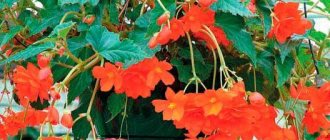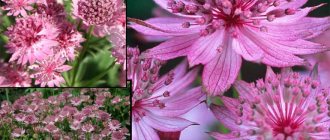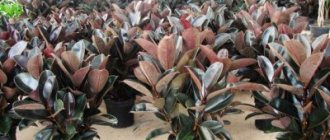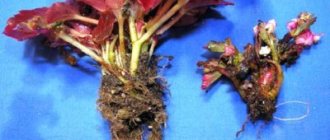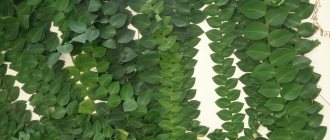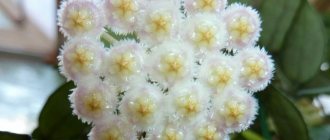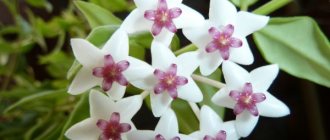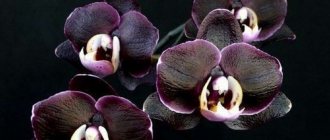Lianas are a special category of indoor plants. With flexible long stems, powerful or graceful, indoor rock gardens allow you to take landscape architecture to a new level. They are grown in amplitudes and on supports, on green walls and in cascades, used for camouflage and even to divide space. Lianas cannot become a real interior decoration without careful care. Any error in them will affect the condition and speed of growth, the density of the leaves and the beauty of the color. These are invariably ornamental plants that depend on their owners even more than bushy herbaceous stars.
Lianas are a special category of peaceful plants
There are many nuances and subtleties of growing vines indoors. Plants that have relatively long stems and can be experimented with using different shapes and gardening techniques require a little more attention than typical houseplants. Pruning, pruning, controlling the rate and direction of growth and straightening are some of the most important measures for caring for a vine.
But the basics - nutrition and watering - for these plants determine the degree of decorative success for many years. Most vines lose some leaves and bare the lower parts of the stems when there are moisture problems, and too much or too little nutrients irreversibly impair growth and development.
And capricious vines are more dependent on humidity than ordinary perennials. But at the same time, vines are the most sustainable, durable and reliable landscaping option. Apart from basic, impeccable care, they often require little effort.
Creepers constantly add volume, open up new possibilities and are suitable for both beginners and experienced florists. Lianas require regular, systematic care and respond gratefully to attention and care. There are general rules for growing them, which should not be forgotten under any circumstances.
Individual approach
Each vine is unique and needs its own special care plan. And the easiest way to avoid mistakes is to document the procedure schedule and installation characteristics. A small sign or tag on the pot with general information about preferences, a moisture indicator, a log of fertilizing, watering and replanting is not only the best way to provide the plant with everything it needs, but also the easiest way to identify and analyze errors.
The choice of plant must be approached responsibly, and not rely only on impulse or appearance. Vines, even if they are elegant hanging plants, are plants that bring joy to the home for many years. Doing your research, checking the details provided by the seller, and assessing your options and your home based on your plant preferences will help you get off to a good start in using climbing plants. After observing the quarantine period, the plant quickly and painlessly adapts to the interior.
The most important aspect of the custom approach is pruning. This is done in accordance with species-specific recommendations and after careful analysis of the plant itself. But watering, fertilizing, replanting, and even choosing conditions should be carried out taking into account the requirements of a particular plant.
Scindapsus. Dennis Amit
Passionflower
The daily growth in comfortable conditions of passionflower (Passiflora caerulea), a special vine in every sense, can reach 10 cm, not to mention how quickly it grows over the season.
The evergreen vine is famous for its huge, star-shaped flowers that look like fancy orders with a luxurious crown around the pistil and stamens. But the beauty of the shiny, five- or seven-lobed, up to 20 cm in diameter, rich green leaves should not be underestimated.
Passionflower clings to supports and surfaces with its tendrils, almost never stopping, requires strong regular pruning and rarely fits on a window. A cool dormant period without fertilizing is rather conditional for it, and it adapts to lighting much better than its reputation suggests.
Passionflower (Passiflora caerulea). © flowercouncil
Watering stages = development stages
The water needs of all indoor plants vary depending on the stage of development and time of year. With vines, it is important not only to maintain a regular watering schedule, but also to adapt watering to changing moisture requirements.
During active growth, all vines need much more water than during the dormant period. Excessive watering in the summer and during the active growth of young shoots can be forgiven by the vine, but it will never go away in the winter. With drought it’s the other way around—it has less effect in winter than in summer. For all vines, complete drying out of the soil is a phenomenon that should be avoided. If, as a result of a combination of circumstances, the soil becomes very dry, instead of resuming watering, moisten the soil by submerging, allowing all excess water to drain.
The surest way to avoid troubles associated with improper watering is to constantly check whether the soil is dry. Watering recommendations for each houseplant also indicate how long the soil should dry out between waterings.
And a few more tips for watering vines indoors:
- Water from trays must always be drained;
- Lianas prefer morning watering;
- When watering vines, be careful not to wet the base of the stems and avoid wetting the leaves.
- Lianas are sensitive to the properties of water, so you should not ignore the instructions for watering with soft or settled water given for each species;
- reduce and resume abundant watering gradually, not abruptly, trying to gradually adapt the plant;
- The water temperature for vines should not be equal to the temperature of the air and substrate, but exceed it by several degrees, especially during the period of active growth;
What types of homemade liana-shaped flowers are there: names of species and photos
Creepers are plants with long, flexible stems that help them climb upward or spread along the surface.
Most often they are planted in hanging pots so that they hang down beautifully or special supports for shoots are installed. There are many varieties of indoor vines. Let's look at some of them.
Scindapsus
This perennial evergreen vine has dense, heart-shaped leaves. Their color can be uniform bright green or variegated with spots.
The thick stem of scindapsus can grow tens of centimeters in a year . This is one of the most unpretentious and shade-tolerant plants and will feel good in any conditions.
Philodendron
It is characterized by large, wide leaves on thin stems. The shape of the leaves depends on the age and variety. The plant is thermophilic and requires good lighting and high humidity.
The flower grows easily and bushes well if pinched in a timely manner. Philodendron is poisonous, and it is better to care for it with gloves.
Syngonium
With regular watering, the syngonium grows up to 1.5 meters. Leaves may be green, white or variegated. The support gives the plant additional decorativeness.
The flower loves diffused lighting, spraying and temperatures of 18-25°C.
Syngonium simply reproduces, since under each leaf there is a bunch of roots that can easily grow to moist soil by touching it.
Stephanotis with white or purple flowers
This is a large vine that can grow up to 5 meters. Stephanotis or indoor jasmine is a flowering vine. Its pretty flowers are white, cream or purple.
Stephanotis grows quickly and branches well, so it requires a lot of free space. The plant is very light-loving; in winter it is advisable to use lighting.
Passionflower
The main decoration of this hanging vine is its flowers. They have bright double perianths up to 10 cm in diameter.
Passionflower has many varieties, most of which are quite difficult to care for. The plant loves bright light and grows well on southern windowsills. Watering should be plentiful and humidity should be high.
Ivy
This is one of the most popular and unpretentious vines. Ivy quickly entwines the support with the help of adventitious roots. Its original shiny leaves can be variegated or dark green.
The plant loves spraying, abundant watering in summer and moderate watering in winter. Ivy can adapt to any lighting regime, but does not bloom in partial shade . There are many varieties of it of different shapes and colors.
Air humidity directly determines the condition of the leaves
Indoor vines have a very large vegetative mass. A large number of shoots and leaves makes the plant more susceptible to deviations from a comfortable humidity level. While in other plants fluctuations in humidity and short periods of dry air can be compensated for, vines usually react immediately, starting with drying out the tips of the leaves and ending with weakening of growth. The more the vine loves moisture, the more carefully you need to monitor the indicators.
Spraying is necessary for all vines without exception, except those whose leaves are covered with hairs. By refreshing leaves and increasing air humidity, it also prevents plants from overheating and allows them to compensate for evaporation to a much greater extent. Always spray in the morning and never in direct sunlight.
Apply only at room temperature or above. For vines that do not tolerate dry air, spraying alone is not enough. This can be supplemented or replaced by installing humidifiers - trays with wet moss or expanded clay, special devices.
Cissus. hopefulauthor
Philodendron climbing
Climbing Philodendron (Philodendron hederaceum) has an annual growth of 1 m. But this is not the only thing that distinguishes the unique species of philodendrons from its relatives. But the most important thing. It is for its rapid growth that the vine is valued all over the world. But the speed of development allows plants to be kept indoors only up to a certain age and size.
The long shoots of climbing philodendron are almost invisible behind the huge, showy forest green leaves. Widely heart-shaped and leathery, they quickly double in size and appear as luxurious scutes.
Philodendron needs coarse, special soil containing peat, bark, and sphagnum. The decorative effect of leaves directly depends on the quality of fertilizing and stable air humidity. But this vine does not have a dormant period.
Climbing Philodendron (Philodendron hederaceum). © plantsandpondering
Hygiene is important, regardless of size
Regardless of the type of vine, no matter how gigantic it may be, the plants must be protected from the accumulation of dust and dirt. At least once a week, depending on which method is suitable for the leaves, the plant should be vacuumed. If the plant is large enough, has glossy leaves and is not afraid of moisture, it is better to give it a shower.
Careful control is as important for indoor vines as for any other care item. As part of spraying or cleaning, regular inspection of foliage is mandatory. Look for any abnormalities, including discoloration, on the undersides of leaves and stems. Even if there are no signs of disease or pests, early detection of problems will make management adjustments easier.
All grapevines depend on access to fresh air. Stagnant and uncirculated air not only leads to greater accumulation of pollutants, but also maximizes the risk of pest infestations. Rooms for vines should be regularly ventilated to protect plants from temperature changes and drafts. Unless they are one of the fussier species, it is recommended to place them on an open balcony - if not in the garden - for the summer so they can enjoy the fresh air.
Rejuvenation and reproduction
Many indoor vines shed their lower leaves as they mature, leaving behind a bare vine with a dozen leaves at the end. This happens especially often in herbaceous vines after winter. In this case, the plant needs rejuvenation: the apical cutting with leaves is cut off and rooted. The old plant is cut to almost half: this way it will branch more strongly. The sections must be treated with a weak solution of potassium permanganate.
The apical cutting, cut from an old plant, can be placed in water so that it takes root. But many indoor vines (like Ivy) have aerial roots, and therefore the cuttings can be immediately dug into the ground.
For quick rooting, a cutting cut is treated with “Kornevin”, or folk remedies - aloe juice or Kalanchoe juice.
In addition to the vegetative method, vines are propagated by seeds. For example, I sowed Passionflower and got very good results in the form of strong shoots. But I do not recommend propagating other types of vines in this way.
In addition to seed propagation and rooting of apical cuttings, some vines can be planted using a propagation method such as dividing a bush.
Loosening, as for garden plants
For vines growing indoors, the soil should be loosened periodically to prevent compaction and maintain optimal air and water permeability. Regeneration of the structure of the top layer of the substrate is especially important for large plants that are not replanted every year.
Over time, in the absence of scarification, actively growing vines suffer not only from soil compaction and even crust formation, but also from soil contamination. With regular loosening, you can prevent problems with the soil and remove plant debris in a timely manner. Weakening the substrate for indoor vines has its own rules:
- This should be done superficially, to a depth of no more than 1.5 cm;
- Very carefully loosen the soil around the sides of the pot, being careful not to disturb the shoots or roots.
Stephanotis. jmchapp
Ivy
Moving into rooms, the well-known garden ivy (Hedera helix) does not lose its ability to grow rapidly. Of course, indoor varieties are much more compact, interesting, variable and... slow. But only at first. In the first 2-3 years, ivy grows very slowly, but then it is able to add 1 m per year.
Ivy hardly needs any introduction. In rooms, offices, official institutions, this is the most versatile, strict and reliable hanging, draping, ground cover and screen plant. Three-, five- or seven-lobed, curly, interesting, densely leathery, shiny, with light veins or patterns - ivy varieties surprise only from the pleasant side. The length of shoots up to 5 m in indoor ivy is rare, because for the purpose of thickening they are most often limited to acceptable sizes.
In order for ivy to show its beauty, one must not forget about spraying, average air humidity, protection from overheating, and a consistently moist substrate. It loves moderate temperatures, bright lighting and cool wintering, in which it simply blooms.
Common ivy (Hedera helix). © PERFECT PLANTS
Micro and macroelements are equally important
When fertilizing domestic vines, it is difficult to make a mistake: in order for the plant to receive all the necessary nutrients, it is enough to follow the instructions for the type of fertilizer, as well as the frequency and period of fertilizing. However, when caring for indoor vines, a serious mistake is often made: when choosing fertilizers, only the ratio of macroelements is taken into account.
For actively growing and heavy plants, trace elements are no less important than nitrogen, potassium or phosphorus. When signs of individual nutrient deficiencies appear, nutrients should be applied as soon as possible, and when choosing the type of fertilizer, always use products specifically formulated for grapevines or a complete multi-nutrient fertilizer.
Calcium is important for the vine to ensure growth and formation of young shoots, magnesium to maintain uniform color, iron, which is also responsible for the growth and quality of leaves, as well as sulfur, copper, molybdenum and manganese.
It is not recommended to use long-acting fertilizers for vines: the risk of uneven absorption of nutrients for them is much higher than for other indoor plants. In the case of climbing plants, it is better to reduce the concentration of fertilizers, but fertilize more frequently, rather than using high concentrations.
Other fast-growing indoor vines
These are not the only plants that can add 70 cm or more per year. The darling of the new millennium, the waxy and perfect Hoya , the good old classic Tradescantia , the inimitable green clouds of the always appropriate cissus (Cissus rhombifolia), the unexpectedly graceful filamentous succulent ceropegia , the dazzlingly beautiful, lush-leaved and original flowering Chinese clerodendrum (Clerodendrum chinense), which puts on an unforgettable tropical show of Mandevilla , and the unforgettable Madagascar jasmine Stephanotis floribunda also pleasantly surprises with its growth rate.
But you can always give a chance to record holders who grow several meters of shoots in just a few months, morning glories and thunbergias !
Transplantation is carried out only upon request
Only young vines should be replanted each year. The older and larger the plant, especially if it is formed on supports that are difficult to transfer to other containers, the less often it needs to be replanted, postponing this until the roots have completely mastered the substrate.
If the vines grow quickly, roots appear in the holes within a few months, and the plant itself does not tolerate containers that are too spacious, do not wait for a favorable period for replanting in the new spring, but replant then and as often as necessary, up to several times a year.
Passionflower. T. MA
Common groundsel
The ragwort (Senecio macroglossus) is the most extravagant plant of the ragworts, which is difficult to recognize as a relative of Rowley's ragwort, and other species from the amazing Senecio genus. But over time, the amazing speed of growth and its benefits become apparent.
The appearance of the large reed ragus resembles either hoya or ivy. Even a simple form captivates with thick, if not fleshy, intensely shiny, leathery, fancy three-lobed leaves with a special texture. And in the variegated variegated form, the most popular of this plant, white spots, veins and patterns create an unforgettable effect. Thin shoots with almost no aerial roots are able to twine around thin supports. This plant does not bloom in rooms.
This type of ragwort can reveal its beauty only in the brightest possible light, with good ventilation, abundant watering and high air humidity.
Common groundsel (Senecio macroglossus). © makeroomforplantz
8. A healthy vine starts with a quality substrate
The soil for vines should be selected individually depending on its reaction, composition and mixture ratio. However, there are general criteria for the substrate in which climbing plants are grown indoors. The soil must be nutritious, airy, loose in structure, not subject to compaction over time, sufficiently coarse-grained and permeable.
Soil structure is determined by the type of root system, choosing light soils for plants with thin and weak roots, medium soils for fast-growing vines and heavy soils for bushy vines with thornless stems and strong rhizomes grown in the largest containers.
For any vine, loosening and disinfecting additives such as charcoal, wood ash, moss, bark, vermiculite, perlite, expanded clay, etc. are welcome.
Lianas require high drainage. Even with the best care, vines, especially hanging ones, are much more likely to get wet than ordinary indoor plants. Drainage can prevent many problems, stabilize conditions, and relieve pressure on containers when growing in hanging pots.
Diseases
Almost all vine diseases are associated with water imbalance.
If you notice that the plant has begun to weaken and lose leaves, then it is quite possible that the reason is that its roots are rotting. This happens when waterlogging occurs and the pH of the soil shifts to the acidic side. But indoor vines shed leaves and if the air humidity in the room is too low, the leaves dry out just before they fall.
- Dieffenbachia - care, photos, types
Dry air and lack of moisture lead to spider mites, aphids and scale insects growing in indoor vines. It is difficult to get rid of them: you will need to spray them twice with Fitoverm or Actellik insecticides.
So it’s better to prevent the disease by following all the rules of agricultural technology for vines, and then any of them will become a decoration for your home.
9. Transplantation should be carried out with utmost care.
Before transplanting, evaluate the condition of the plant and your own capabilities. Large vines, due to their heavy weight (and often the medium size of internal vines), usually cannot be transplanted alone. The number of workers must be sufficient not only to cope with the heavy root ball, but also to protect all shoots and leaves from injury.
It is best to replant each and every vine with minimal root contact. Only the top and loose layer of soil should be removed from the root ball. If the soil needs to be completely replaced, the root ball should be carefully loosened and the roots should be soaked in a weak solution of a fungicide (at least potassium permanganate).
If the roots are exposed, trim any roots that are too long and remove any damaged or dry areas. For plants with a very dense root ball resulting from a long absence of replanting and almost complete absence of soil in the root ball, make longitudinal cuts. Even if the vine is not capricious, the absence of unnecessary trauma to the roots will allow it to adapt and grow faster.
The day before transplanting, the vine should be watered to facilitate the procedure. When replanting, act quickly and do not allow the roots to dry out. It is recommended to control the level of submergence by maintaining the plant at the same level and ensuring that the root collar is approximately 2-3 cm below the edge of the pot, so that the top layer of soil can be replaced in the future without replanting.
The vine should be positioned exactly in the center of the pot, without moving, which could make the container unstable as the plant grows. The substrate should be poured in small portions, leaving it loose and not too compacted.
Hoya. Silas Price
Akebia
Akebia quinata is a chocolate vine that not everyone decides to grow in their room yet, because it is a real giant even in a potted format. Annual growth is from 1 to 3 m in nature and only slightly less in rooms. True, it is quite easy to restrain the growth of a plant.
Akebia got its name as a chocolate vine for the dizzyingly delicious aroma of its flowers. During flowering, which lasts from April to August in comfortable conditions, the original purple female and light pink male flowers bloom. And all this time you can’t move away from the vine, because you just want to unravel the nuances of the smell.
And although akebia does not bear fruit, the beauty of this semi-evergreen steeplejack with purple shoots that can easily cover any support with five-lobed shiny leaves in one season is quite enough.
Akebia needs a cool winter, and without it you can’t count on success. She loves the sun and air, is not afraid of drafts, but is sensitive to dampness. And it grows well even at low air humidity.
Akebia quinata. © guildfordgardencentre
3-4. Syngonium peduncle and scindapsus aureus
At the same time, on the seedling window sill grew a leg-leaved syngonium with paper-thin, relatively large leaves of a white-green color and a golden scindapsus with dense heart-shaped leaves of cheerful spotted yellow colors.
Syngonium podophyllum. © sommai damrongpanich
Golden scindapsus (Scindapsus aureus). © samacharjagat
They were destined for permanent registration in the bathroom. A good place for plants is a western orientation, the window is a bit high, but the white tiles provide the plant with good reflected light. Warm and humid. In general, these two appreciated the floristic paradise.
The scindapsus grew with one vine, and the syngonium shot out with several shoots, conquering space for itself. A year later, a green gazebo was formed, promoting thoughtfulness and contemplation. Constant care was only watering and removing old dried leaves from the syngonium. And the fastening of all this green riot. Our guests really, really loved visiting our home “gazebo.”
The active growth of the syngonium required adding soil approximately once every quarter; the soil in the pot noticeably decreased. There were no diseases or pests on them, no spraying was required, and even dust collected on the leaves was several times less than in living rooms.
Unfortunately, in the third year in winter, the already mature syngonium (this is noticeable in the shape of its leaves - they become “eared”) became bare from below and lost its former decorative effect. Various stimulating methods in the form of pinching, incisions over the kidneys did not have a positive effect. I had to cut everything off, root the tops and start all over again.
The decorative effect of the bathroom has changed dramatically - instead of a green riot, there are exquisite curves of one scindapsus stem with leaves highlighted in yellow.
Similar and different traits of vines
Lianas grow and are easily propagated using cuttings and take root just as quickly. Therefore, the flower easily took root in the room conditions. All vines have many similarities, but there are also differences. Some of them have a flexible stem, others have a grassy base, while the base of other vines becomes woody over time.
They may have different growing seasons, the crops may be annual, but perennial representatives of vines are also grown in apartment conditions. They are evergreen or may lose their leaves at certain times of the year.
If we talk about indoor vines, they are usually evergreen and perennial. Also, in apartment conditions, herbaceous vines grow, but in a personal plot you can plant flexible or woody crops.
Plant branches are attached to the surface in different ways. Based on this type, breeders even divide indoor vines into subspecies. Among them:
- root-climbing vine, attached to the support with the help of roots;
- climbing or tendril-bearing appearance, involves fastening the plant with the help of lateral shoots or tendrils;
- leaning vines are attached to the support using suction cups.
Gentle handling is the most important thing after transplantation
After transplanting, the home beauty is watered generously in small portions to evenly moisten the soil. The watering schedule is approached gradually. To avoid injury to the roots and slower growth, you should not add fertilizer for 1-1.5 months, since when transplanting there are enough nutrients in the soil that are so important for the plant.
Do not leave the vine near heating appliances, avoid direct exposure to sunlight. Air humidity should be high and be about 60%. When the plant adapts, check the condition of the leaves and new shoots and feel free to return the vine to its usual place.
